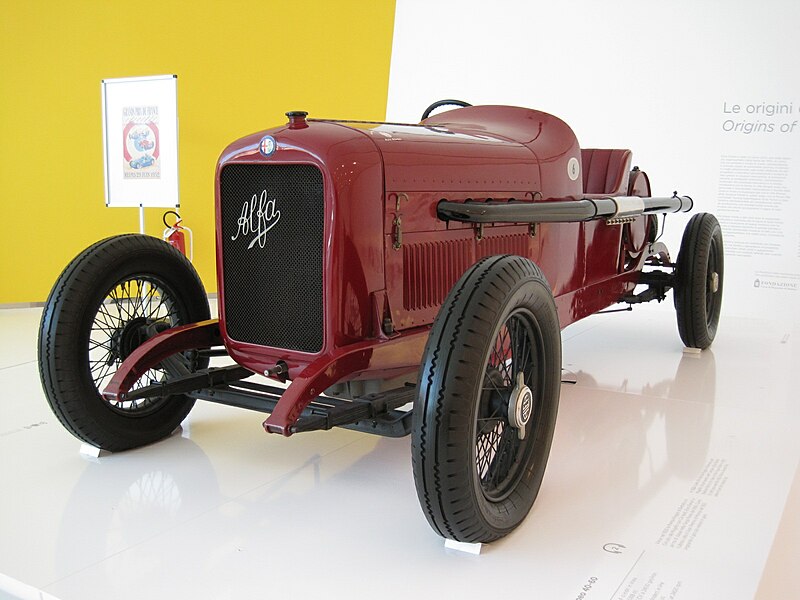Road cars
1910-1920 24 HP
1910-1911 12 HP
1911-1920 15 HP
The ALFA 24 HP is 4.1-litre four-cylinder passenger car, the first model produced by Italian car manufacturer ALFA (Anonima Lombarda Fabbrica Automobili), which in 1919 would become Alfa Romeo. It was introduced in 1910, the year ALFA was founded, and produced until 1914 in ALFA's Portello factory near Milan. The model's name comes from its tax horsepower rating, then frequently used as vehicle designation.
The 24 HP was commercially successful and continued to be developed for a decade. In 1914 some updates transformed the 24 HP into the ALFA 20-30 HP, produced in 1914 and 1915—with some hundred cars assembled after the war in 1920. In turn the 20-30 HP evolved into the 1921–22 Alfa Romeo 20-30 ES Sport, the first car to be badged Alfa Romeo from its introduction.
1913-1922 40-60 HP
The ALFA 40/60 HP is a road car and race car made by Italian car manufacturer ALFA (later to become Alfa Romeo). This model was made between 1913 and 1922 and was designed by Giuseppe Merosi, as were all other Alfas at that time. The 40/60 HP has a 6082 cc straight-4 engine with overhead valves, which produced 70 bhp (52 kW) and its top speed was 125 km/h (78 mph). The race model 40-60 HP Corsa had 73 bhp (54 kW) and a top speed of 137 km/h (85 mph), and it also won its own category in the Parma-Berceto race.
In 1914 the milanese count Marco Ricotti commissioned to Carrozzeria Castagna the ALFA 40/60 HP Aerodinamica (also known as Siluro Ricotti), a prototype model which could reach 139 km/h (86 mph) top speed. A replica of that car was created in the 1970s, and now it is shown in the Alfa Romeo Historical Museum.
40/60 HP production and development was interrupted by the First World War, but resumed briefly afterwards. 40-60 HP Corsa had now 82 bhp (61 kW) and a top speed of around 150 km/h (93 mph). Giuseppe Campari won the 1920 and 1921 races at Mugello with this car.
Racing cars
1911 15 HP Corsa
1913 40-60 HP Corsa
1914 Grand Prix
ALFA 40/60 GP or GP (Grand Prix) was a fully working early racing car prototype made by the company now called Alfa Romeo. Only one example was built in 1914, which was later modified in 1921. This was creation of Giuseppe Merosi and was first Alfa Romeo DOHC engine. It had also four valves per cylinder, 90 degree valve angle and twin spark ignition. Usually Alfa Romeo DOHC engines are thought to be Vittorio Jano's creations but the first one was Merosi's GP car. This kind of engine architecture was very new for the time, originating from 1912/1913 Peugeot designed by Swiss engineer Ernest Henry. The history of this engine architecture is unclear, but other cars with dual overhead camshafts in the era were made by Sunbeam, Delage and Humber. This 1914 GP car was intended to take part in French Grand Prix of that year, but for reasons unknown this never happened. In 1921 Giuseppe Campari took part in the Gentlemen G.P. in Brescia with the modified GP car, but was forced to retire due to a leaking radiator.
The GP engine had a displacement of 4.5 litres (4490 cc) and produced 88 bhp (66 kW) at 2950 rpm and after modifications in 1921 102 bhp (76 kW) at 3000 rpm. The top speed of this car was 88-93 mph (140–149 km/h). It was not until the 1920s when these DOHC engines came to Alfa road cars like the Alfa Romeo 6C.




.jpg/800px-Giuseppe_Campari_in_his_Alfa_Romeo_40-60_HP_at_the_1922_Targa_Florio_(cropped).jpg)










.jfif)

No comments:
Post a Comment